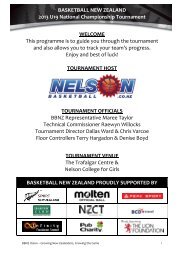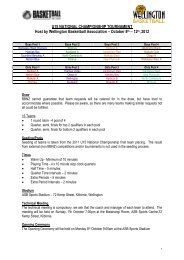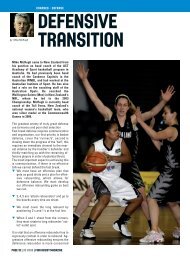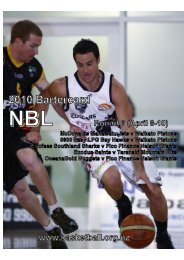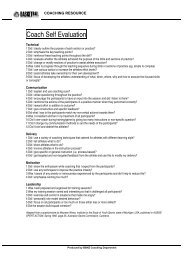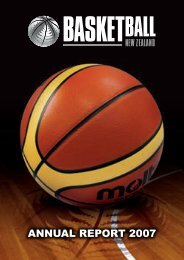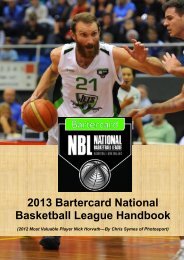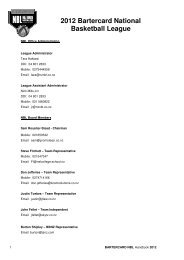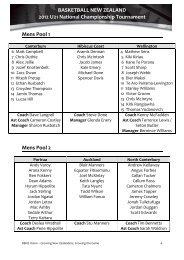Basketball Operations Manual - Basketball New Zealand
Basketball Operations Manual - Basketball New Zealand
Basketball Operations Manual - Basketball New Zealand
Create successful ePaper yourself
Turn your PDF publications into a flip-book with our unique Google optimized e-Paper software.
Harassment-Free <strong>Basketball</strong> Procedures<br />
Sport gives a great deal of enjoyment to <strong>New</strong> <strong>Zealand</strong>ers.<br />
As well as being fun, sport can provide important opportunities for personal development.<br />
Success in sport can be a source of personal achievement and national pride. In some<br />
cases, sport can become a person’s livelihood.<br />
Every participant in sport, in whatever role, has a right to participate in an environment<br />
that is fun, rewarding, safe and healthy, and to be treated with respect, dignity and fairness.<br />
This means that physical or verbal abuse, harassment of a sexual or non-sexual nature,<br />
sexual abuse, and exploitation have no place in sport.<br />
The policy and these procedures form part of a harassment-free strategy in basketball. The<br />
strategy aims to create a safe environment by developing a system of dealing effectively and<br />
appropriately with, and whenever possible, preventing harassment in basketball.<br />
These procedures in particular have been developed to assist you to understand your obligations,<br />
and to take the necessary risk management measures to protect your organisation<br />
and its members from legal action in this area.<br />
More importantly, they are intended to help you ensure that everyone involved in your<br />
organisation — be it the athlete, coach, instructor, teacher, administrator, official, parent or<br />
volunteer — gets the greatest possible enjoyment out of their sports participation and is safe<br />
from harm.<br />
What is Harassment?<br />
Harassment is defined from the viewpoint of those being harassed. Whether the action was<br />
intended as harassment or not, does not matter. Intention only matters when determining<br />
what disciplinary action is appropriate.<br />
Harassment is not:<br />
• appropriate compliments;<br />
• behavior based on mutual attraction;<br />
• friendly banter which is mutually acceptable; or<br />
• constructive coaching and feedback.<br />
In most cases, harassment (including sexual harassment) is an attempt by one person to<br />
inappropriately exert power over another person. Harassment ranges from mild conduct<br />
such as gestures or comments to conduct which may be physical, forceful and violent. Examples<br />
of harassing behaviors include (but are not limited to):<br />
• written or verbal abuse or threats;<br />
• the display of visual materials which are offensive;<br />
• unwelcome remarks, jokes, comments, innuendo or taunting about such things as a person’s<br />
looks, body, attire, age, race, religion, sex or sexual orientation;<br />
• leering or other suggestive or obscene gestures;<br />
• practical jokes which cause awkwardness or embarrassment, endanger a person’s safety or<br />
negatively affect performance;<br />
• unwanted physical contact including touching, petting, pinching or kissing;<br />
• unwelcome sexual flirtations, advances, requests or invitations;<br />
• sending offensive emails, letters or phone calls;<br />
• deliberately excluding people with the intention of isolating or hurting them; or physical<br />
or sexual assault.<br />
100 2007 NBL <strong>Operations</strong> and Rules <strong>Manual</strong>




